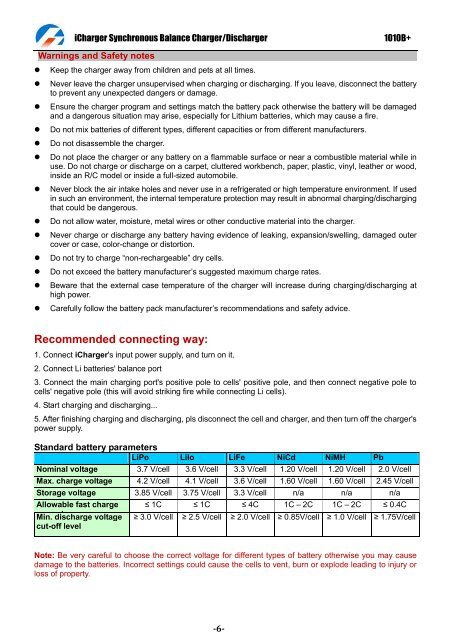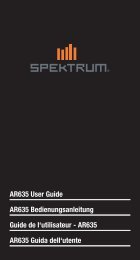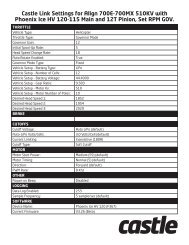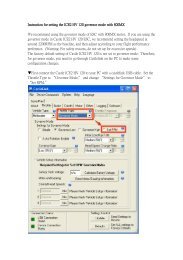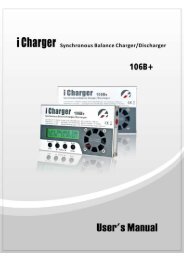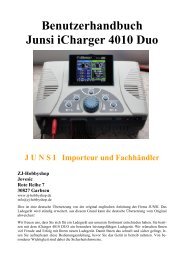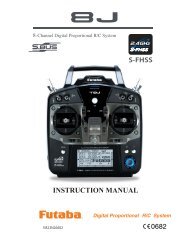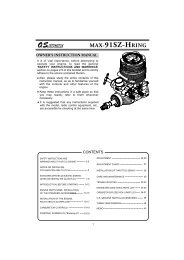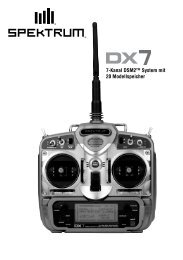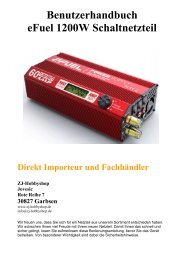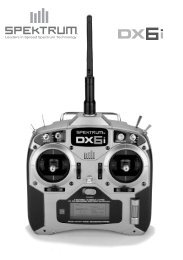iCharger 1010B+
iCharger 1010B+
iCharger 1010B+
You also want an ePaper? Increase the reach of your titles
YUMPU automatically turns print PDFs into web optimized ePapers that Google loves.
<strong>iCharger</strong> Synchronous Balance Charger/Discharger <strong>1010B+</strong><br />
Warnings and Safety notes<br />
Keep the charger away from children and pets at all times.<br />
Never leave the charger unsupervised when charging or discharging. If you leave, disconnect the battery<br />
to prevent any unexpected dangers or damage.<br />
Ensure the charger program and settings match the battery pack otherwise the battery will be damaged<br />
and a dangerous situation may arise, especially for Lithium batteries, which may cause a fire.<br />
Do not mix batteries of different types, different capacities or from different manufacturers.<br />
Do not disassemble the charger.<br />
Do not place the charger or any battery on a flammable surface or near a combustible material while in<br />
use. Do not charge or discharge on a carpet, cluttered workbench, paper, plastic, vinyl, leather or wood,<br />
inside an R/C model or inside a full-sized automobile.<br />
Never block the air intake holes and never use in a refrigerated or high temperature environment. If used<br />
in such an environment, the internal temperature protection may result in abnormal charging/discharging<br />
that could be dangerous.<br />
Do not allow water, moisture, metal wires or other conductive material into the charger.<br />
Never charge or discharge any battery having evidence of leaking, expansion/swelling, damaged outer<br />
cover or case, color-change or distortion.<br />
Do not try to charge ―non-rechargeable‖ dry cells.<br />
Do not exceed the battery manufacturer‘s suggested maximum charge rates.<br />
Beware that the external case temperature of the charger will increase during charging/discharging at<br />
high power.<br />
Carefully follow the battery pack manufacturer‘s recommendations and safety advice.<br />
Recommended connecting way:<br />
1. Connect <strong>iCharger</strong>'s input power supply, and turn on it.<br />
2. Connect Li batteries' balance port<br />
3. Connect the main charging port's positive pole to cells' positive pole, and then connect negative pole to<br />
cells' negative pole (this will avoid striking fire while connecting Li cells).<br />
4. Start charging and discharging...<br />
5. After finishing charging and discharging, pls disconnect the cell and charger, and then turn off the charger's<br />
power supply.<br />
Standard battery parameters<br />
LiPo LiIo LiFe NiCd NiMH Pb<br />
Nominal voltage 3.7 V/cell 3.6 V/cell 3.3 V/cell 1.20 V/cell 1.20 V/cell 2.0 V/cell<br />
Max. charge voltage 4.2 V/cell 4.1 V/cell 3.6 V/cell 1.60 V/cell 1.60 V/cell 2.45 V/cell<br />
Storage voltage 3.85 V/cell 3.75 V/cell 3.3 V/cell n/a n/a n/a<br />
Allowable fast charge<br />
current<br />
Min. discharge voltage<br />
cut-off level<br />
≤ 1C ≤ 1C ≤ 4C 1C – 2C 1C – 2C ≤ 0.4C<br />
≥ 3.0 V/cell ≥ 2.5 V/cell ≥ 2.0 V/cell ≥ 0.85V/cell ≥ 1.0 V/cell ≥ 1.75V/cell<br />
cut off level<br />
Note: Be very careful to choose the correct voltage for different types of battery otherwise you may cause<br />
damage to the batteries. Incorrect settings could cause the cells to vent, burn or explode leading to injury or<br />
loss of property.<br />
-6-


